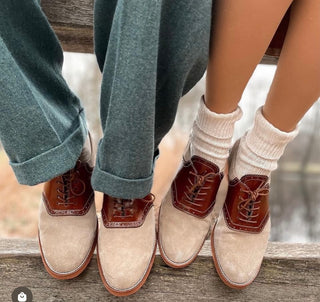Are Saddle Shoes in Style?
We think so! Saddle shoes are a timeless and eye-catching choice. They add a fun, vintage touch to any outfit without feeling too dressed up. With a long and interesting history, saddle shoes have gone from sporty footwear to fashion icons.
Why Are They Called Saddle Shoes?
Saddle shoes get their name from the unique saddle-shaped piece of leather that sits across the middle of the shoe, often in a contrasting color. First introduced in the early 1900s, they were designed as athletic shoes for sports like golf and tennis. The saddle overlay added extra durability and support, taking inspiration from Oxford shoes.
Everyday Style
By the 1930s, saddle shoes moved beyond the gym and became popular everyday footwear for men, women, and kids. They were especially common with school uniforms and were a big hit among teens. The classic look—white leather with a black or brown saddle—became a symbol of youth and neat, preppy style. Later, brands offered them in other two-tone color combos and materials.
 The wonderful @strawberrystarlette and @daveetheewave wearing my unisex Elliot saddle shoes in a stylish 1940's ensemble.
The wonderful @strawberrystarlette and @daveetheewave wearing my unisex Elliot saddle shoes in a stylish 1940's ensemble.
When Were Saddle Shoes Most Popular?
Saddle shoes hit their peak in the 1950s. They were a go-to for teens, especially girls, who wore them with bobby socks and poodle skirts for that iconic '50s look. Movies and TV shows helped boost their popularity, turning them into a true piece of pop culture.
Made for Dancing
Because of their flat soles and comfort, saddle shoes became favorites on the dance floor—perfect for swing, jitterbug, and other high-energy styles. Even now, vintage dancers love them for their retro charm and practicality.
From Trend to Classic
In the 1960s, new shoe styles like loafers and sneakers became more popular, and saddle shoes started to fade from the mainstream. But they never fully disappeared. They’ve made comebacks over the years, especially among fans of vintage fashion, rockabilly, and retro Americana. In the 1980s and 1990s, they had a revival and still pop up today in vintage-inspired wardrobes.

@strawberrystarlette and @daveetheewave showcasing a very youthful look in my Elliot saddle shoes.
What Exactly Are Saddle Shoes?
-
Saddle Design: A saddle-shaped leather panel across the top, often in a darker or textured color.
-
Two-Tone Look: Usually white with black or brown saddles, but many versions exist.
-
Flat Sole: Durable, low heel with either leather or rubber soles.
-
Tied to Youth Culture: Especially popular in mid-20th-century America as part of teen and school fashion.
What Are Two-Tone Shoes?
"Two-tone" simply means a shoe that uses two different colors in its design. This can apply to many styles—formal or casual—and covers various materials and constructions. Undercategories of the two-tone shoes, features the saddle shoe, spectator shoes and regular derbys and oxfords in two-tone colors. Grace is our Derby women's spectator shoe in a brown and white two-tone color.
 A classic 1940's every day outfit with pants, featuring our Grace two-tone shoes and our 1940's inspired Lisbeth cardigan.
A classic 1940's every day outfit with pants, featuring our Grace two-tone shoes and our 1940's inspired Lisbeth cardigan.
Saddle Shoes vs. Spectator Shoes: What’s the Difference?
While both are two-tone shoes, saddle shoes and spectator shoes are quite different in design and purpose.
Saddle Shoes
-
Feature a dark leather “saddle” across the middle of the shoe.
-
Low-heeled Oxford style with closed lacing.
-
Started out as sports shoes in the early 1900s.
-
Became a big part of school and teen fashion in the 1940s and '50s.
-
Worn casually, often with uniforms or vintage-inspired outfits.
-
Built for comfort and durability.
 Our Elliot saddle shoe is a perfect throwback to 1950s youth culture—made from suede and full-grain cognac leather with brogue detailing and a lightweight rubber sole. The closed Oxford-style lacing keeps it true to its roots.
Our Elliot saddle shoe is a perfect throwback to 1950s youth culture—made from suede and full-grain cognac leather with brogue detailing and a lightweight rubber sole. The closed Oxford-style lacing keeps it true to its roots.
Spectator Shoes
-
No saddle panel—color contrast appears on the toe, heel, and sometimes sides.
-
Usually a Derby shoe with open lacing.
-
Made for dressier occasions; often leather in white with black or brown.
-
Became popular in the 1920s–30s jazz era, worn with suits and dress trousers.
-
Sleek and refined, great for semi-formal to formal wear.

Our Grace spectator is a true classic—brown and white with full brogue details, tassel laces, a Derby-style opening, and an almond-shaped toe.
Want to Learn More?
If you’re interested in more classic footwear stories, check out our article on the saddle shoes two-toned brother: The spectator shoe in our article The History of Two-Tone Spectators: A Vintage Icon
Or find out more about the fashion of the saddle shoe’s heyday—the 1950s—in our article on 1950s style: 1950’s fashion - How did people dress in the 1950's?
Sources:
-
Vintage Shoes by Caroline Cox
-
Shoes: An Illustrated Story by Rebecca Shawcross


